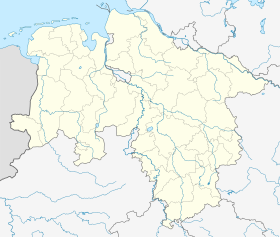Barstede
|
Barstede
Ihlow municipality (East Frisia)
Coordinates: 53 ° 25 ′ 51 ″ N , 7 ° 21 ′ 58 ″ E
|
|
|---|---|
| Height : | 0 m |
| Area : | 10 km² |
| Residents : | 361 (2013) |
| Population density : | 36 inhabitants / km² |
| Incorporation : | July 1, 1972 |
| Postal code : | 26632 |
| Area code : | 04928 |
Barstede is a district of the East Frisian community Ihlow in Lower Saxony . The population was 361 in August 2013, the area around 1000 hectares.
location
Location of Barstede in Lower Saxony |
Barstede (consisting of the parts of the village Alt- and Neu-Barstede) is a moor settlement that merges into the settlement area of the municipality of Südbrookmerland in the north . There are bus connections to Aurich and Emden . Barstede is located a few meters above sea level on a geest called Sandhöchte. The Ems-Jade Canal runs through the south of the village, and the area is characterized by the numerous drainage ditches of the moors.
history
Barstede was mentioned for the first time in 1408, but the place, which had had a church since around 1280, existed much longer. In view of its location away from the old Aurich-Emden postal route (which is why the term Abseitsdorf was common for a long time), Barstede developed only slowly. The parish took over the Reformation and its innovations in the 16th century, which included the list of Barsted parishes, which has been continuously drawn up since 1540. In 1644 the East Frisian Count Ulrich II from the house of Cirksena donated a baroque winged altar to the church . Since the beginning of the 18th century A school is also documented in the village, whereby the Prussian authorities since 1744 recorded the contentious character of the peasants on the occasion of a local revolt over the choice of school teacher. Barstede suffered from the Thirty Years and the Seven Years' War . In 1822, in addition to the agriculturally oriented southern Alt-Barstede, the northern workers' settlement Neu-Barstede was added, although its lower location offered less protection from floods than Alt-Barstede.
On July 1, 1972, Barstede was incorporated into the new municipality of Ihlow.
Attractions
The most important building is the Barsteder Church , whereby today's neo-Romano - Gothic building was built in 1953 on the site of the older church, which has been increasingly in danger of collapsing since the end of the 19th century. Older interior fittings were taken over, however. In addition to the baroque winged altar mentioned, this includes an approx. 800 year old baptismal font and an organ built by Johann Gottfried Rohlfs in 1801 as well as a pulpit from the 17th century. The free-standing bell tower of the oldest building from the 13th century has also been preserved to this day.
The so-called Schatthaus, today one of the eight large farms in the village, is also important, but the impressive building reminds us that it used to belong to the castle of the local noble family, which was built by Udde Riekena in 1448 but demolished in 1790. Until 1788 the farmers were obliged to serve the aristocrats, with milk processing being the main focus in Barsted agriculture. The Barsteder farmers were not obliged to serve the Rykena. It was an aristocratic free estate, or a former rural farm that received aristocratic rights. However, the estate did not belong to the registered knighthood. Such services of the peasants had also been abolished by the national treaties.
Individual evidence
- ↑ Barstede Current . Ihlow parish. Archived from the original on October 17, 2013. Info: The archive link was automatically inserted and has not yet been checked. Please check the original and archive link according to the instructions and then remove this notice. Retrieved October 14, 2013.
- ^ Federal Statistical Office (ed.): Historical municipality directory for the Federal Republic of Germany. Name, border and key number changes in municipalities, counties and administrative districts from May 27, 1970 to December 31, 1982 . W. Kohlhammer GmbH, Stuttgart and Mainz 1983, ISBN 3-17-003263-1 , p. 261 .
Web links
- Barstede Current . Ihlow parish. Retrieved October 14, 2013.
